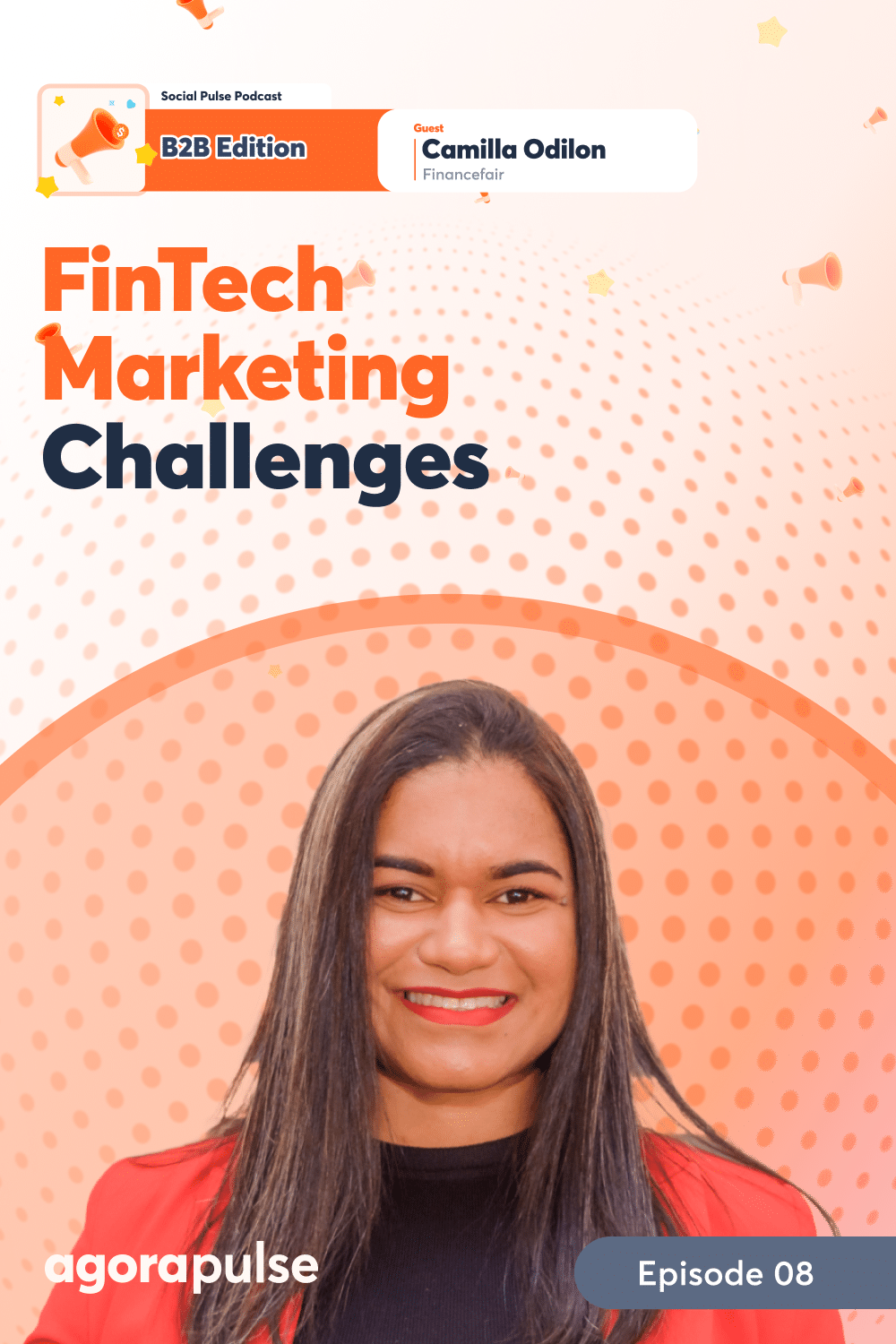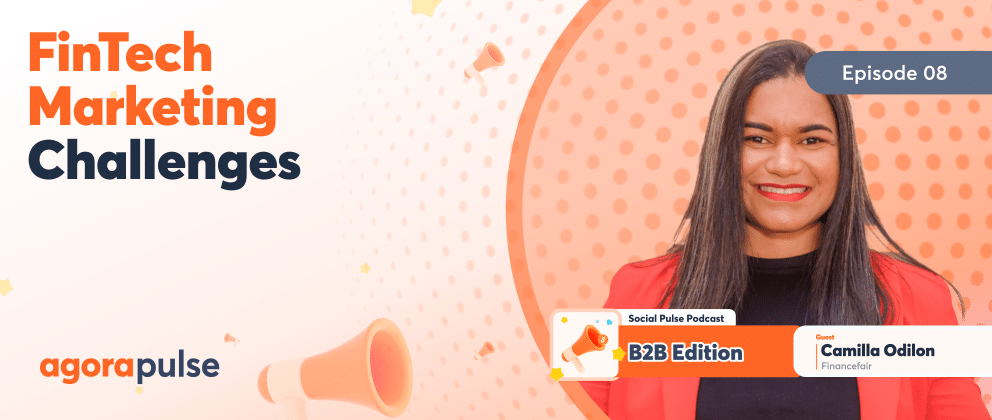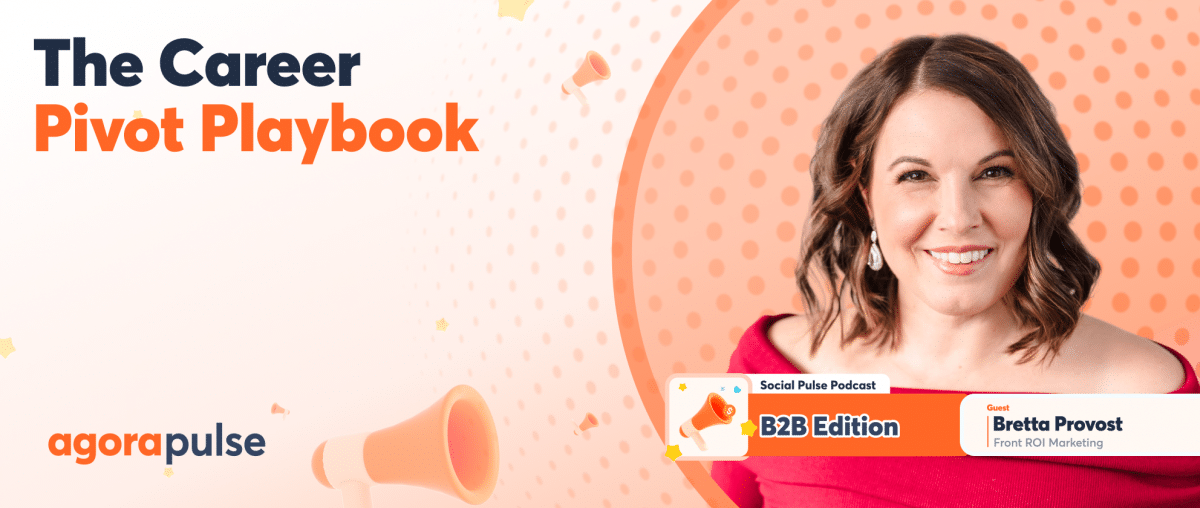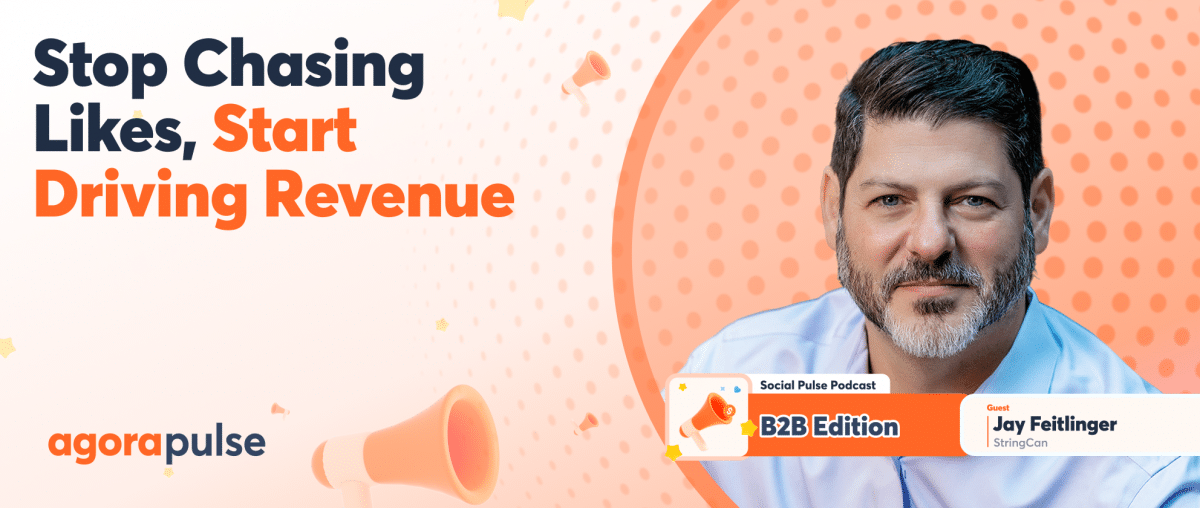Are you a FinTech or a B2B marketer struggling to convince your traditional management team of the value of digital marketing? Do you find yourself caught between the promise of innovative digital strategies and the resistance of executives who still cling to offline channels?
You’re not alone. In today’s rapidly evolving financial landscape, many marketers face the challenge of bridging the gap between cutting-edge digital marketing techniques and the more conservative aspects and expectations of organization leadership.
How do you demonstrate the ROI of digital campaigns to skeptical executives? What strategies can you employ to gradually shift your company’s marketing focus from traditional digital channels? And how can you navigate the often frustrating process of educating management about the realities of modern marketing in the digital age?
That’s exactly what Social Pulse Podcast: B2B Edition guest Camila Odilon discusses in this episode.
[Listen to the entire podcast, hosted by Agorapulse’s chief storyteller, Mike Allton, or read on for the transcript below.]
FinTech Marketing
Mike Allton: I’m so excited to have you here.
If you could start by just sharing a bit more about that background that I just teased and how you came to specialize in FinTech marketing.
Camilla Odilon: I’ve been working in digital marketing for over 10 years. (So maybe that’s my age.) I started my career in Brazil, and now I’m based in Ireland.
So along the way, I’ve worked on campaigns for the U.S. audience, Ireland, and the UK. I’ve got a lot of experience across different markets. I’ve done pretty much everything marketing, if you know what that means. I have experience with customer service, creative building websites, and managing teams and 20 others.
But what I enjoy is creating strategies that grow the business and also make the work environment better for the marketing teams.
So right now I’m the head of digital marketing at Finance Fair, an Irish fintech company. I love taking up a new challenge, and Fintech definitely brings a lot of them. My experience in B2B marketing, which I’ve been doing for over six years—B2B has been super valuable in this role, but it’s not a part of my story. I moved to Ireland in early 2020, just about six weeks before the pandemic began. And I didn’t speak any English at all. So my English just from the last four years, it was really hard, really hard to get a Critical Skills Visa in Ireland [and] find a job in my area. Even though I had a lot of experience, it was a tough time.
But it’s led me to create the Marketing Ireland Community. It’s a free online platform where immigrant marketers can find information and support. So between working full time at Finance Fair and running this community, I keep pretty busy. And when I’m not doing that, I will probably go hiking in the Irish mountains with my two cats.
Digital Marketing Challenges
Mike Allton: Let’s talk about digital marketing in this FinTech space. ‘Cause I am sure you have faced some pretty unique challenges in trying to convince some traditional management that [they] should probably do this digital marketing thing.
What [challenges] have you come up against?
Camilla Odilon: One situation that stands out is when we were in a meeting to discuss a new product. All the leaders were sharing ideas, but everything seemed to revolve around individual perspectives rather than actual data or what the manager needed.
I spoke up and said, “This idea sounds great, but where is the data?”
So later the same day, I did some quick research using Google Trends, which is a free tool that shows search volume for keywords in a specific region.
And just with the basic research, I just realized we were heading in the wrong direction.
So I dug a little deeper and used that data to present my insights to the team.
- In some cases like this, I’ve been successful in getting management to listen to me, but there are other times, especially more traditional industries like construction that I had. I think I was in construction for the last three years, where even with clear data management, I was still more focused on vanity metrics, likes, and followers rather than metrics that matter for the business goals.
- For example, if we’re trying to increase sales of a building, I’m going to focus on metrics like the number of opportunities created, MQLs that the marketing qualified leads, MQL costs, and sales conversion rate. Things like likes and followers won’t be my priority if that makes sense to you, but sometimes management gets caught up in those numbers, which can be dangerous if you know as they lose sight of what really drives growth.
So that’s what’s happened to me for the last 10 years.
Demonstrating ROI
Mike Allton: I’d love it if you could talk a little bit more about what you’re doing when it comes to demonstrating ROI—particularly to marketing executives or organizational leadership—but they’re maybe more familiar with traditional marketing metrics.
How are you approaching the demonstration of ROI?
Camilla Odilon: I like to keep it simple and focus on what matters: business impact.
The reality is, at the end of the day, everyone wants to know what the cost is [and] how much you spend. That’s what I can see from my experience. Instead of talking about clicks or impressions, I show how digital marketing directly contributes to things like lead generation, cost per lead, and I also compare digital metrics to what are they really know.
- For example, if they understand foot traffic in stores, I compare that to website traffic, but then show how digital allows us to track every step. That is the beauty of the digital market. So I literally drive them from click to sales, and then they can properly understand if they don’t really have much idea about digital marketing and how we do everything.
And lastly, I always tie everything back to the overall business goals, like revenue growth or cost savings. So they see the bigger picture and they love the marketing sector when you focus on that.
Mike Allton: That is so true. I don’t really talk about a lot, but a couple of decades ago, I was in traditional marketing. I was working for a firm where I was purchasing billboards and Yellow Pages—half of you probably don’t even know what Yellow Pages are, but they were phone books and you could have advertising. But to your point with digital, we can track almost everything, so it should be very magical. And yet I know still a lot of traditional organizational executives, they’re uncomfortable with that.
And so I’m wondering if you think back to some of the executives that you’ve worked with who maybe were disbelievers in digital marketing, but you turn them around.
Could you share an example of a successful digital marketing campaign that you implemented that helped change management’s perception of digital marketing?
Camilla Odilon: I remember a time when my manager knew we needed a digital marketing strategy. But he didn’t understand it.
The sales team also didn’t get how marketing could help, which made it hard for me to get their support for a lead generation plan using LinkedIn Sales Navigator and other tools.
So I took the initiative, as someone had to, and spent four months building a system that aligns marketing and sales. (The reality is that when you need to show quick results, you have to stay close to the sales team. We have to collaborate. So if you don’t do that, it’d be really hard to sell quick results.)
And I saw I needed that. I spent these four months doing everything. I create content, reach out to the right people, and make materials to attract and nurture our audience. I even sent physical kits to the office and followed up with emails. So I was doing every single part of the process. I believed them in this strategy. In the end, we signed two service contracts with multinational companies, and one of them was worth 90,000 euros.
The success changed how our team worked together and helped them see the value of digital marketing. The reality was that one day, it started with just one service, then the second one, and the third. The first question was, “Oh, how did you do that?”
Were there any particular tools or techniques that you had employed to help you connect the dots and track that success?
Camilla Odilon: For that specific strategy, I was using a lead generation approach based on LinkedIn data. Essentially, I created a streamlined process because, on LinkedIn, you can precisely segment your audience by title, industry, and region. There’s a wealth of demographic data, as well as other relevant information, if you truly understand your Ideal Customer Profile (ICP).
And then for that product, our audience was at LinkedIn, which didn’t make any sense. They spend money just to create ads on Google. I needed really a personalized approach, but to know how to make a personalized approach, I needed the same support: What are the pain points? How is the actual approach? What is the ICP that is the decision maker? What is the ICP that is the influencer?
Have all the details, create content, and then approach them through LinkedIn. This strategy was key for our approach at that time.
Sometimes we need luck, but it was hard work, and I utilized it. I think Apollo was really good for integration with Sales Navigator and LinkedIn Premium, which were both crucial for that strategy. And sometimes, we just have to pray!
Navigating Success (Both Fast and Slow)
Mike Allton: So that last campaign that you were just telling us about, it sounds like you were able to achieve success relatively quickly, but we know most of the time with digital marketing, it takes a long time to see any kind of success, but we also try to have to balance that with that need for quick results.
How are you navigating that—particularly in this kind of industry?
Camilla Odilon: What I can say is that when we talk about quick results, we always need to assess if that really makes sense. If the focus is solely on achieving quick results, it’s essential to evaluate whether that is feasible. Sometimes companies want quick results, but it’s not always possible if that makes sense to you.
- First, I try to determine if the goals are realistic. I genuinely want the company to succeed, but I like to compare it to visiting a doctor. Nobody tells a doctor to fix a health problem on their schedule; people usually respect the doctor’s advice. In marketing, some managers think they know how to fix things, but they put too much pressure on the team for quick results, which can really bring everyone down. I definitely want to see results quickly, and my teams know I’m all in when it comes to making the business successful.
- However, I also believe in respecting how long things take and avoiding burnout within my team. I like to consider both outbound and inbound strategies for quick results. It depends on how we define quick results. Typically, outbound strategies yield much quicker results. (For example, with inbound marketing, creating content is a long journey—it may take six months or even a year to see predictable results that significantly impact revenue.)
- On the other hand, outbound efforts, such as ads, cold calls, or new campaigns can deliver results in two to three months. Everything depends on the business goals and how they approach achieving quick results. I’ve reached a point where I understand that when a company wants quick results without taking responsibility, it is not sustainable for the business or the team.
What are some other misconceptions you think are in FinTech and B2B marketing particularly that you might’ve had to address with some of these other executives?
Camilla Odilon: I wouldn’t say there are specific misconceptions, but I’ve noticed that many professionals in the companies I’ve worked with need a better understanding of what digital marketing is and how it works.
So for me, this isn’t a problem at all because I love teaching. I run digital marketing workshops for the Marketing in Ireland community for my members, and I have even lectured in a postgraduate course for a few years in Brazil. So educating my colleagues has been a big part of my work over the past 10 years, and I’ve learned a lot from them too.
Staying On Top of Things
Mike Allton: So talking about educating your management and your colleagues, there are so many trends in digital marketing. There are so many changes in technology. We haven’t even talked about AI. There’s so much going on!
How do you help keep them up to date? I mean, how do you limit what they need to know about at the same time and make sure that they know what they need to know, particularly when it comes to B2B and FinTech marketing?
Camilla Odilon: Recently, I have developed a strong passion for learning and enjoy being in the learning process every single day, to be honest. I recently finished my MBA in Data Science applied to marketing, and I learned a lot about data and artificial intelligence.
AI, as you mentioned, is a big topic right now, and I share everything I learn with management and my team. We use various AI tools that make our work smarter and more efficient. I also emphasize the importance of understanding the user purchasing journey and explain how staying updated on trends helps us make better decisions that align with what users want.
The way I educate my team and management is similar to this: Sometimes you have a Ferrari, but you don’t know how to use it properly. That’s how I see it when you have good software and tools, but no one is using them effectively.
Sometimes, team members are only using 5 percent of the tools, yet they ask, “How can we use artificial intelligence?”
I respond by saying, “Let’s use the basics well first!”
I often spend time reviewing how to use the tools we already have and ensuring everyone follows the basic processes. This approach allows me to introduce new concepts while reminding the team of the importance of consistency. I believe this is extremely relevant for the business.
Changing Your Mind About Trends
Mike Allton: I’m wondering if you can think about some of the instances in the past where you’ve been teaching yourself about these new tools, new resources, new tactics, new trends, and you’ve realized that you’ve got your own bias, whatever that might have looked like.
What was that? How did you overcome it? And what did you learn from that experience?
Camilla Odilon: I’d say there was a time when I thought email marketing was bad—like see you later, email! You know how every year, there’s an article claiming a certain strategy is dead?
What I learned is that no strategy is bad; it’s about finding the right fit for what you need.
Sometimes we just have to tweak how we do things a bit.
Now I believe we should only abandon a marketing channel when we truly understand why. I keep my mind open to new ideas and tried-and-true methods because you never know which strategy might surprise you. (For example, I always said I didn’t like cold emailing; it just didn’t make any sense to me.)
But then I had experiences in two different businesses where cold email accounted for between 17% and 23% of sales in the whole company. That’s a lot! We never know what could work.
As marketers, we should stop and think about what we like, but we also have to focus on what the business needs. That’s what I’ve learned so far.
Is there anything that you’re particularly excited about when it comes to B2B marketing again—whether that’s a tactic, a trend, or a tool?
Camilla Odilon: I’m excited about lead generation!
To be honest, I’m constantly testing different strategies. At one stage in my professional life, I believed everything was about having the right tools, and while that’s partly true, I’ve come to realize that the way you use those tools makes a huge difference.
Sometimes two different sectors or teams might use the same tools, but the way they personalize their approach, take care of their leads, and understand the buying journey can make a total difference. Now I’m a huge fan of testing—like MVP testing, failing fast, and fixing things quickly.
That’s definitely what I love.
Thank you all of you for listening and reading! That’s all the time we’ve got for today, friends, but don’t forget to find the Social Pulse Podcast: B2B Edition on Apple and leave us a review. We’d love to know what you think until next time.






